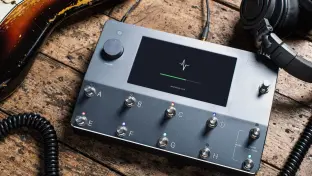
Quad Cortex Development Update #25

Formerly Quad Cortex Development Update - June 2022
Things rarely are as they seem from the outside.
It has been a year since we published a development update, during which we had just begun beta testing CorOS 1.1.0 and shipped our 5,000th Quad Cortex. The past twelve months have flown by, seeing us release 10 CorOS updates and ship over 15,000 units total. Several highly requested features have also been added, such as the Minivoicer, Looper, Stomp Mode multi-bypass assignment, Freeze, and Preset & Capture bundling, in addition to an ever-growing list of modeled devices.
For a company as dynamic as Neural, there are always several parallel threads that we at the helm must keep track of, working with people leading teams in a wide variety of disciplines, making sure everything they need to do their best work is being provided by us.
Neural is more like several smaller companies under one umbrella: initially, we were known as a plugin studio, developing great software tools that make world-class tones accessible to guitarists and bassists. For the years in which we were known as a plugin studio, we were silently working on the Quad Cortex, engineering hardware as well as designing and developing embedded software.
For better quality control and an immediate feedback loop from the factory floor to the engineering team, we decided to run our own production. In addition, we also provide cloud services that are an integral part of the Cortex ecosystem, so we have also become a fully-fledged manufacturing company and cloud services platform.
Quad Cortex was announced shortly before COVID. Completing the product under such circumstances was a huge challenge. Setting up our factory amid constrained logistics and COVID restrictions while overseeing the remaining development of the product required a lot of resilience and constant context-switching for many of us.
Some of the ripples of COVID are still making manufacturing very difficult to this day. Halfway through 2021, silicon shortages began to bite hard. At the beginning of 2022, it was clear that things would get a lot worse before they would get better, which translated into a very bleak outlook; we may have virtually no parts to ship any hardware for the most of 2022.
Shortly after, when we saw no signs of availability normalizing in the foreseeable future, we began to re-work our hardware and software to be compatible with different critical components—whatever we could source by the thousands (or tens of thousands!) This meant redesigning PCBs and re-writing drivers, among other tasks that took time away from teams who could be making new features or testing new models and often made us feel like we were back to square one.
Sourcing these new parts, prototyping, and testing the re-worked versions to ensure that every bit of performance remained unchanged not only meant a huge amount of additional manufacturing, hardware, and software engineering work, but also our finance department had to work around the clock to make sure we had enough working capital to absorb the additional millions of dollars worth of parts we required.
As if this wasn’t enough, we had another aggravating factor: the unprecedented logistics bottlenecks of our overseas electronics suppliers. There was a severe container shortage last year, and various lockdown-related disruptions both in factories as well as ports meant that shipping costs were higher and several times longer; therefore, I made the hard decision to move that entire operation to Finland.
This in itself was also a Herculean task—to synchronize the transition of manufacturing complex electronics and supply chain management from one vendor to another under unprecedented availability constraints gave a lot of us many sleepless nights, but now it’s running almost at capacity and the results are great. It was risky and painful but a good decision nonetheless.
Fortunately, all of these measures have allowed us to keep the factory running (at a limited capacity at first), but at least some units were being shipped, and most importantly, our amazing manufacturing team stayed employed.
Now the situation looks better. We should be able to operate at full capacity from late June/July and unless there are any further cataclysmic surprises, start ramping up production during the fall to the tune of thousands of units per month.
Many very smart people have and continue to work like hell to overcome all of this. In a typical year, doubling or tripling manufacturing capacity is incredibly tough. This was like trying to do that on Nightmare Mode, but I could not be more proud and grateful for all the ingenuity and relentless resourcefulness displayed to get through it.
This crisis has affected other areas, as many of us had to drop or take time from whatever we were working on to make sure we could survive these unprecedented challenges. Regardless, we have been able to carry on working on supporting the Cortex platform.
When we announced Quad Cortex, we issued a few directives:
A desktop controller will be released shortly after the launch.
Plugins would soon be available on Quad Cortex.
Hybrid Mode.
1. Desktop controller
The desktop controller has been a priority since we launched Quad Cortex, and personnel from our plugin teams have been allocated to the project, working alongside embedded and cloud teams to create a beautiful and seamless experience unlike any desktop controller we have ever seen.
It was in retrospect overly optimistic for us to announce that the desktop controller would be available shortly after launch, but we are making solid progress nonetheless. The UI and two-way communication are complete, and the teams are working on the finer details of backups, cloud communication, and the more complicated differences in which a desktop application utilizing a mouse and keyboard functions differently to a device with a touchscreen and rotating potentiometers.
If we have learned anything from our announcements regarding Quad Cortex development, it’s that promising features and timelines set an expectation that lead to disappointment when we delay a release because we want to perfect things. All of that to say we are pleased about the progress with the desktop controller and we can't wait to share it with you.
2. Plugins on Quad Cortex
Making the plugins available on Quad Cortex is no small task. The difference in architecture and embedded software (the operating system running on Quad Cortex vs macOS/Windows) means components have to be ported and meticulously validated to ensure they sound exactly the same. Additionally, our modeling approach has evolved significantly over time, and earlier amp models were developed using methods that are not QC-friendly. In these cases, we are implementing many of them from the ground up. We are doing this while modeling and validating new (non-plugin) amplifier models for QC.
3. Hybrid Mode
Hybrid Mode was announced in one of our earlier development updates when a prototype had been completed. We had every intention of shipping it at launch, but due to the shifting nature of everybody’s workloads leading up to the launch, it got moved far down our list of priorities. We hope to be able to include it in CorOS 2.0.0, provided everything goes smoothly.
Redesigned File Manager
While not announced at launch, another project we have mentioned a few times is the redesigned file manager. This is a deep overhaul that runs through all of CorOS, and as such it will be released as part of our first major update, CorOS 2.0.0. The new file manager comprises several layout and quality of life improvements that will vastly improve how you find, navigate, organize, edit, download, and share files throughout Quad Cortex. It has been a huge undertaking by our UX team, software engineers, and cloud team, and I’m sure you’ll agree that the results will have absolutely been worth the wait.
Thank you
In an effort to do more and move faster, we are expanding our team quite aggressively. If you are interested in joining the 100+ Neural team, feel free to check our careers section to see the current openings.
Thank you for all the support and patience. This has been an uphill battle since the go, but we are very grateful for the opportunity to learn and overcome.
Doug Castro

